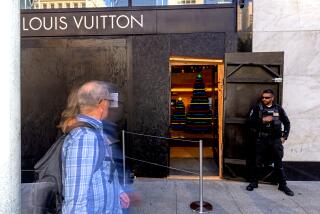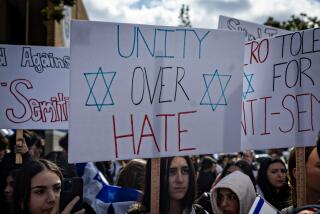Op-Ed: Why L.A.’s crime rise is no surprise
- Share via
After more than a decade of decline, violent crime in Los Angeles rose more than 20% during the first half of 2015, with felony assaults up 26% and robberies up 19%. Why, no one yet definitively knows. But there’s plenty of speculation.
Straight off, most criminologists will tell you that crime goes up, crime goes down, and sometimes it’s a trend, or just a blip, apart from anything the police are doing. Others will point out that violent crime in cities like Los Angeles may have plunged so deeply in recent years — to historic modern lows — that it simply bottomed out.
Here in Los Angeles, the rise might also be attributable in part to the Los Angeles Police Department crime stats simply being reported more honestly. An irrefutable Los Angeles Times investigation of the department’s crime numbers for the first half of 2014, for example, discovered the misclassification of 1,200 violent felony assaults as misdemeanors, thus making it appear that serious violent crime was going down when in fact it went up by 14%.
There are also broader national trends that might be affecting L.A.’s crime rate. According to Ron Noblet, the dean of gang interventionists at the Los Angeles Urban Peace Institute, the heroin epidemic plaguing the Northeast has finally started to hit Los Angeles.
“It’s moving now from middle-class kids in the west San Fernando Valley to Chicano and African American areas such as South Los Angeles and East L.A.,” says Noblet. Thus we might be seeing heroin become a crime-rise factor like crack was in the 1980s, both in terms of strung-out users committing crimes to feed their addiction and gangs fighting turf wars over drug distribution rights.
But I’d like to take an educated guess on what might be the key factor causing L.A. crime to rise: Something may be happening akin to the eras of the Watts riots of 1965, the high-crime crack war years of the 1980s and early ‘90s, and the 1992 Los Angeles riots. And it’s this: a new Gilded Age of obscene wealth, stunning, low-wage income disparity and grinding poverty have come together to make ghetto and barrio life ever more desperate. As a result, the steam is once again pressing against the engine cap, just as it did during those infamous times.
To explain more fully requires a quick look at recent L.A. history.
By the early 2000s, many of the players involved in the gangster violence of the late 1980s and ‘90s were out of the game: drugged-out, aged-out, locked up or dead. At the same time, the broader demographics of South L.A. were dramatically changing. As black gangs devolved in the housing projects of Watts and other nearby neighborhoods, Central American and Mexican immigrants — who, as a number of studies have pointed out, have a strong work ethic and low crime rates — moved in.
But in the 15 years since 2000, a new generation of L.A.’s ever-expanding legion of the poor has grown into their teens and early 20s — the prime crime-committing years — and come of age in the fierce, dog-eat-dog economy of the Great Recession. They have faced gasoline prices hovering around $5 a gallon, $13 movie tickets, a bag of groceries costing twice as much as six or seven years ago, and trouble finding even stagnant low-wage jobs or seats at overcrowded community colleges.
Simultaneously, housing in Los Angeles has become the most expensive in the nation, as gentrification is pushing the city’s poor and miserably paid out of their neighborhoods, increasingly with no place to go. Those who remain are living in what social scientists call “severely overcrowded homes,” while services for the poor dwindle. All are incubators of desperation and criminal behavior.
The most vivid example of all this are L.A.’s homeless, the number of whom, like crime, is on a steep rise — up 16% in Los Angeles County, while skid row homeless housing is all but disappearing, also due to gentrification.
Association isn’t causation, but the patterns in the stats are striking. On the streets of skid row and adjacent Chinatown, violent crime has exploded by 67%, property crimes by 26%; and in the LAPD’s Central Division, which polices downtown, felonious assaults have skyrocketed by 80%.
Meanwhile, in the nearby Wilshire Division, the number of homeless has been overflowing from skid row. There, violent crimes and burglaries have increased by 14% and vehicle thefts by 26%. Similarly, in the heart of Hollywood, in the areas framed by Hollywood and Vine, there’s been a reported 140% increase in homelessness along with an overall violent crime rise of 14.7% in the Hollywood Division.
In short, L.A.’s crime rise seems to be part of the same-old-same-old double-downed: raw poverty and rising crime again coming together in an era of astounding, Third World-like income disparity, declining social services and desperate poverty.
We can continue to deny that undeniable truth. But the data are in, the pilot programs and studies completed. We now know definitely what needs to be done to stop the poverty and crime merry-go-round, and it’s not more mass incarceration. We just aren’t willing to pay the cost of systemically, permanently fixing it.
Joe Domanick is the West Coast bureau chief of TheCrimeReport.org and associate director of the Center on Media, Crime and Justice at John Jay College of Criminal Justice of the City University of New York. His latest book is “Blue: The LAPD and the Battle to Redeem American Policing.”
Follow the Opinion section on Twitter @latimesopinion and Facebook
More to Read
A cure for the common opinion
Get thought-provoking perspectives with our weekly newsletter.
You may occasionally receive promotional content from the Los Angeles Times.






